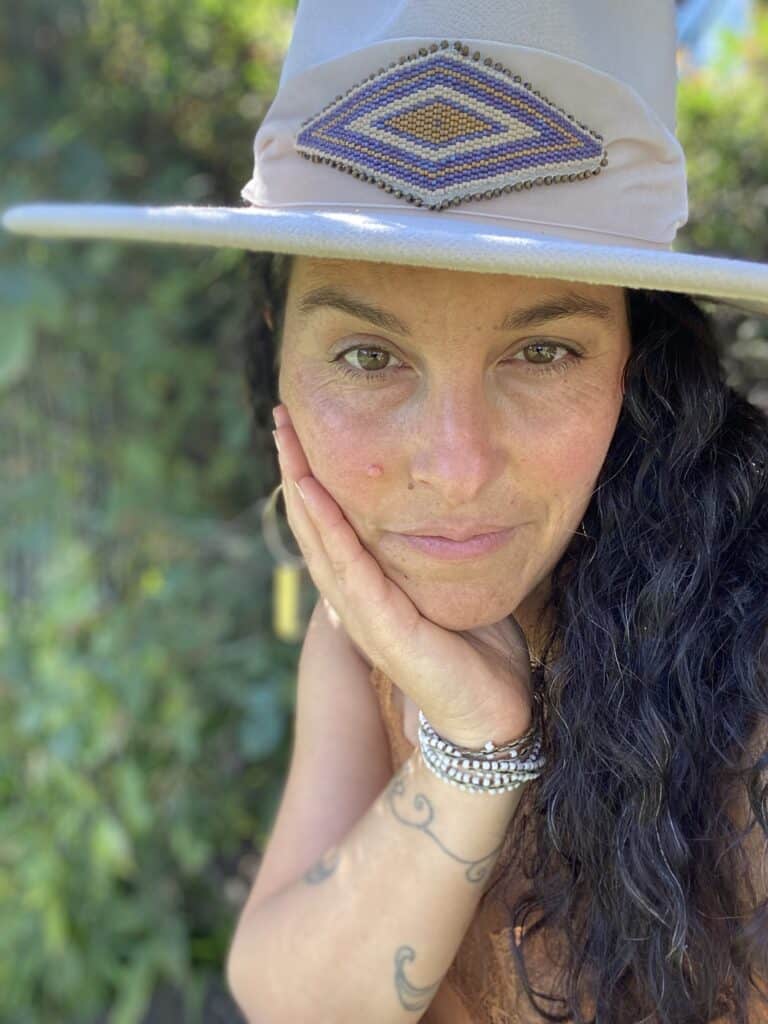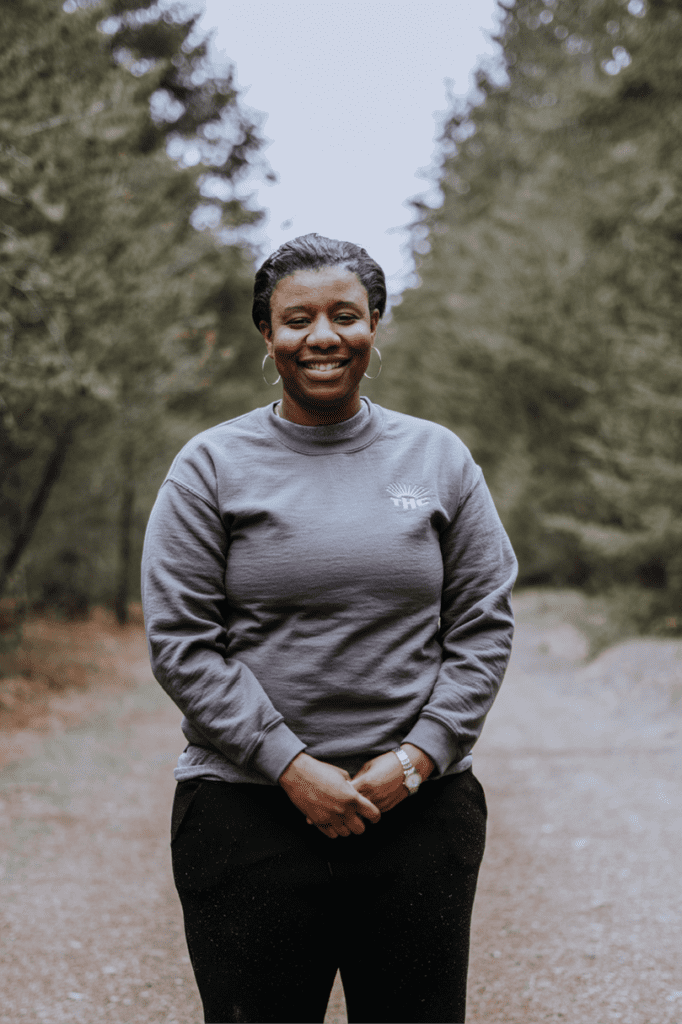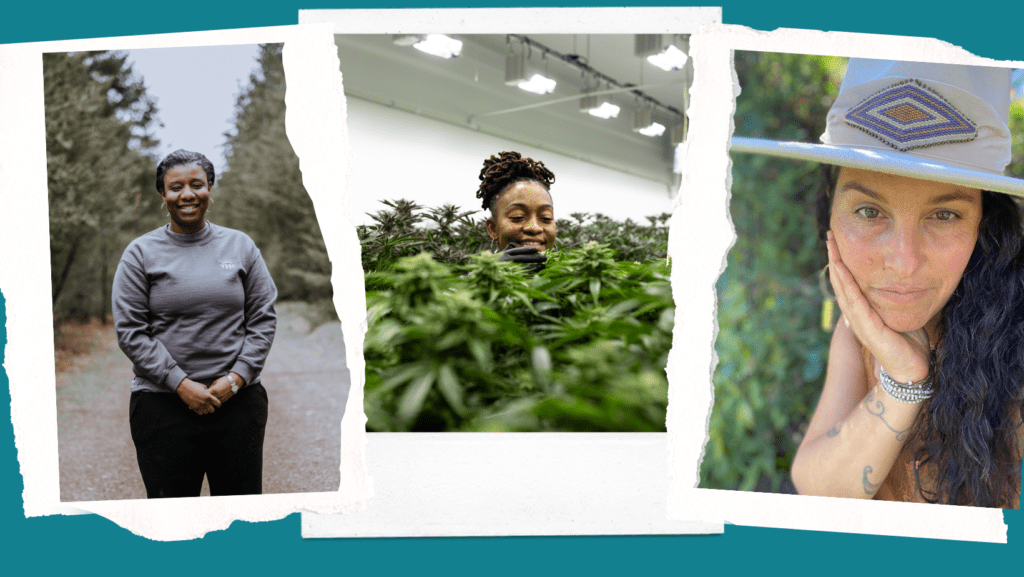The plants were hidden away from Annie’s house on the other side of the canal, and she’d further shielded the garden from sight by planting an encircling arbor wall of scarlet runner beans.
“Aren’t they beautiful?” she asked. It was near harvest and she looked so happy, holding her baby girl in a carrier, standing in her garden surrounded by these majestic, fragrant plants, leaves splayed toward the sun, buds microcosms of glittering color—purple, tangerine, cornsilk, and green. She moved through the plants, plucking a leaf here and there, and I felt like she was introducing me to friends.
This was back before adult-use cannabis was legal in Oregon. At the time, Annie’s partner was a big-time indoor grower. He always had a giant roll of cash in his pocket and moved through the world with all the swagger one associates with the gro-bros of that halcyon era when you could still get 1800 dollars a pound on the illicit market. Meanwhile, Annie was taking care of their baby and homeschooling his two other kids, milking the cows, tending the chickens, cleaning the houses, growing a giant vegetable garden to feed everyone, and cooking for his crews of workers. At night when the kids were in bed, she’d pull bins of weed into the living room and we’d sit up trimming until midnight. This was all work, but her personal garden hidden behind the runner beans was her joy and her nest egg–and there she grew some of the best weed I’ve ever smoked.
Cannabis has a reputation as a male-dominated industry, but there are an awful lot of women cultivators, and there always has been. Sometimes we don’t see them because, like Annie, they are out of the limelight, carrying family and enterprise on their backs. Whatever the case, the best way to make this industry more equitable is to look for them, listen to them, and learn from them. From skilled legacy farmers like Annie who remain in the shadows to the female cultivators who are navigating the perilous waters of an industry on the brink, today we’ll celebrate the industry’s women owners who still keep their hands in the dirt.
“It’s been such a male-dominated industry from the outside,” says Chiah Rodriques of Mendocino. “But really, when you look back at it historically, and I look around my community especially—I know tons of farms in Humboldt and Trinity counties in the Emerald Triangle that are female led…They’ve been doing it for like 20, 30, 40 years or more, and they don’t really get the recognition ever until there’s a brand to put the face on.”

Kikoko, a woman-centric brand founded by Amanda Jones and Jennifer Chapin, recently did just that, which is how Rodriques got on my radar. She’s one of three women growers who provide weed for Wild Womxn Pre-rolls, a product line that honors the women and farming traditions that made the Emerald Triangle famous: organic heirloom cultivars blooming in the fine California sun. Along with Rodriques and Arcanna Flowers, Wild Womxn features cannabis from Tina Gordon of Humboldt’s Moon Made Farms, and Jenn Procacci of Northern Mendocino’s Wildland Cannabis.
Collectively these women represent a culture and cultivation tradition that is in danger of extinction. “I am a daughter of the industry, so I was born into it,” Chiah says. “My dad is a first-generation back-to-the-land hippie, and he was cultivating pretty much my entire life.”
Chiah says her dad showed her some things, but many of his cultivation techniques aren’t applicable now.
“I mean, back in those days he was cultivating in crazy places,” she says. “During the Reagan era you had to hide, right? And so that was always like this shadow, this fear. And so he would cultivate on platforms way up in trees and get all the soil and the water and everything up there.”
She remembers her dad growing his plants in shady ravines and in tunnels he carved through blackberry patches. But ultimately, modern cannabis farmers must work more and spend more money; in her dad’s days, yield wasn’t such a huge concern. Cultivation techniques were simpler and cheaper, and you didn’t have to grow acres of plants in order to survive.
“I mean, I think my dad maybe had like 30 or 40 plants maximum, because if you’re getting three, four, or five thousand dollars a pound you don’t really have to do much to have a decent lifestyle,” Chiah recalls.
Things are different now. Chiah and her husband Jamie, a second generation cannabis breeder, grow up to 2000 plants a year on forty acres in the Redwood Valley.
“We just finished our twenty-third cultivation season together. We’ve been doing this for a long time,” she says. The farm is off the grid and solar-powered. They capture rainwater, practice hugelkultur and companion planting, and combat pests with beneficial insects and sprays made from essential oils.

For Chiah and Jamie, the transition to the legal market has been brutal. They have a generational knowledge of the plant, and the land to grow it on, and the gumption to jump through hoops, but they’ve been nearly strangled by the state’s Draconian regulatory and tax structures. They aren’t alone in this.
Chiah estimates that 90 percent of the families in their rural community are cultivators. And of these 80 or so farming families, only five households even attempted to go legal.
“The problem is the barriers to entry, the barriers to doing business. The barriers to surviving and thriving are so huge that it’s no wonder that not that many people have stepped up to the table,” she says.
The few legacy farms that manage to get their papers in order invariably struggle to compete both with big MSOs and California’s notoriously gargantuan unregulated market. Chiah says that most of their farmer neighbors, both licensed and unlicensed, are hurting.
“You know, really, it is a cultural thing here,” Chiah says. “And I feel like we have to try to save our heritage. Nobody else is going to do it for us, and the time is now to step up and say: This isn’t working.”
A part of the problem is, as usual, both a lack of consumer education and a missing conduit between cultivators and educated consumers. But Chiah is working to get legacy growers the recognition they deserve. She’s a co-founder of the farm collective Mendocino Generations and actively involved the Mendocino Cannabis Alliance , an organization that advocates for small producers and is piloting Mendocino Cannabis Shop, a delivery service which will allow consumers in the Sacramento area to order their weed directly from Mendocino farmers, who will get 90% of the proceeds. Chiah hopes this program can serve as a model for other regions.
Supporting other women in the industry is a core part of Chiah’s mission. She joins other female cultivators for regular panel discussions on industry issues, and she and her friend Patty recently started a podcast called Moms do Weed, where they interview other women in the industry. “Just whatever we’re interested in,” Chiah says, “looking at the issues, but from the perspective of parenting and female cultivation…”
In the past few years, the face of the cannabis industry has changed and women’s voices have grown louder. Women founders are creating brands that speak to women and are designed with women’s health in mind. And with the growth of networks like Women Grow and Women Employed in Cannabis, we’re seeing a tendency toward a less competitive and more cooperative approach to business. Among the woman cultivators I spoke with, a common theme was a commitment to lifting people up.
Joy Hollingsworth and her brother Raft grew up in Seattle’s historically Black Central District, where the War on Drugs destroyed lives and had a ripple effect in the community. In an effort to change that narrative, they got a Tier III producer-processor license, bought property in nearby Shelton, and founded The Hollingsworth Cannabis Company in 2013. Their dad helped them with the startup costs and continues to work at the company.

Neither sibling had real experience farming. Joy was a basketball coach and Raft had grown cannabis indoors for a few years, an experience which they quickly found didn’t translate to the rainswept reaches of the Olympic Peninsula.
“It’s the worst place to grow cannabis,” Joy says frankly and laughs. “You have to deal with massive humidity, you have to deal with rain, you have to deal with all the different challenges that are on the peninsula. We wanted to grow directly into the ground, but the Olympic Peninsula is an old glacier. So you go one foot into the ground, you’re hitting massive boulders, you know? And so like we learned the hard way you can’t do that.”
They’ve dealt with greenhouses collapsing due to freak snow storms and mold problems from perpetually moist conditions. But they learned from every disaster, figured out the best mold resistant strains, upped their game every year, and scraped by in Washington’s competitive market.

Then in 2020, the Black Lives Matter movement rose again to prominence and suddenly Washington’s only Black-owned cannabis farm was a hot commodity.
“We understood that a lot of the attention that we were getting was mainly because we were one of the few Black companies in the industry, particularly on the farming side,” Joy says. “We made a collective effort as a family to use our platform for better, not just putting the spotlight on us. Here’s a great story about a family operation, but how do we use our platform to increase awareness about the significant disparities within the industry and how there is a lack of Black ownership in cannabis?”

When I ask her about her goals, she doesn’t talk about business expansion. Instead she says, “Trying to get more people that look like us in the industry on an ownership level was number one,” and goes on to describe their long-running advocacy work to redirect tax dollars toward the communities most harmed by the War on Drugs. The Hollingsworths also use podcasting as a platform: Their Be Good Daily sheds light on industry issues and provides insights and resources to give BIPOC people a leg up in the industry. The accompanying website includes interesting resources like an interactive map that shows equity organizations and programs across the US.
The Hollingsworths have figured out how to make it work and dedicated monumental time and effort to sharing their hard-earned knowledge. Joy wishes big companies shared their emphasis on community and cooperation.
“I just think there’s room for all of us,” she says, adding, “But I sense the greediness that has destroyed every other industry and market. I see those business tactics every day and it’s just so unfortunate…I’m just scared for the small farms that can’t adapt to the new wave of these larger companies that can not only make weed cheaper, but can take losses just to run people like us out of business.”
Meanwhile in Michigan, LaToyia Rucker of Calyxeum is also using her industry know-how to level the playing field. The Detroit-based cultivator and entrepreneur runs a social equity incubator with her business partner Rebecca Colett, as well as a community garden and other neighborhood improvement projects. They work every day to bring more women and people of color to the table. Part of their commitment stems from their understanding of how difficult it is for small Black-owned and woman-owned brands to get funding. Despite growing killer weed, having a rock solid business plan, collectively possessing four advanced degrees, and building an incredibly stylish and cohesive concept, they’ve had trouble finding investors–they’re currently crowdsourcing.

LaToyia got her start in cannabis as a caregiver for her grandmother who had fibromyalgia. While making edibles for her grandmother and other family members with health problems, she became frustrated.
“I was just getting some really trashy weed,” she says with a laugh. This inspired her to take a cultivation class.
“I had never grown anything, but I really developed a strong passion for it,” she says. “And from there it was just me adding one more plant, and then another plant, and getting another patient and really diving deep into the science of cannabis.”
She read every book she could find on the topic, watched YouTube tutorials, and honed her skills. Today her Candy Gelato is famous in Detroit.
“It was a lot of trial and error, but I never gave up,” she says. “Even now today I’m still learning things about the plant, you know? That’s the cool part about it. You’re always learning, especially as cannabis becomes more and more sophisticated and the grows get bigger and bigger. You want to still yield a high-quality product. So you have to kind of think about like, okay, as we scale, how do we still maintain that high quality? And so, you know, that’s important to me and that’s why I keep going.”
She says it comes down to hard work.
“At the end of the day, I’m in the garden, you know? I got my gloves on, I got my music playing, but I’m working hard. Sometimes I’m working eight, nine hours a day. To make sure that the product that people get is high quality, because I take pride in that. I really do.”


That sense of pride in work was another common theme among the women growers I spoke with. “We are so prideful about the stuff that we put in every product because our mom smokes our own stuff and our grandmother, right?” Joy Hollingsworth says. “We wouldn’t give anybody else what we wouldn’t smoke ourselves. And that’s why we’re proud to be pesticide free and just grow clean, simple cannabis and just, you know, keep it that way.”
Joy credits her interest in cultivation to her mother, who was obsessed with gardening.
“If you go to her house, you’ll see over 50 different types of plants, all in her house. They all have their own food–like she just loves plants, okay? There’s plants everywhere–her garden, her house, her backyard, her front yard. She loves, loves, loves plants.”
Joy’s own love for plants is palpable when she talks about harvesting and hanging her plants. “I love the fresh cut of plants,” she says. “That shit is fire. But it’s also the saddest part, too, because I feel like those plants are living beings, and it’s like, you know, they’re being harvested. And I just feel so bad because you feel so alive when they’re growing, you feel the energy and then their sacrifice–for them to be cut like that is sad, you know?”
That said, she takes a pragmatic attitude toward farming and scoffs at growers who think they’re “the greatest gift to growing.” She says she and her brother have learned as much or more from vegetable farmers—like how to run a tight ship and keep costs low while still growing quality product using sustainable methods.
“We had to learn how to be really efficient,” she says. “We didn’t start with $10 million dollars…We had to be incredibly efficient and incredibly resourceful. Right? Don’t get me wrong—If I had a million, maybe I would spend a million. But we also pride ourselves on not having to spend a lot of money and growing for thirty-five cents a gram based off our unique system.”
When I ask Joy her favorite aspect of being a grower, she deadpans: “Paying taxes.” But then gets serious and says it’s really going into a store and seeing their product on the shelf and the satisfaction of knowing they grew it, processed it, and packaged it themselves. “It started from a mother plant we created, that we discovered was a female and transitioned it to a mom. You know just that piece of knowing that hey, we created it from start to finish. I think that’s really kind of cool.”
My friend Annie never made the jump to the legal industry. She is a second-generation legacy grower with a deep knowledge of beyond-organic practices, but she couldn’t afford the high cost of entry caused by Oregon’s Byzantine compliance and licensing requirements.
“I’m happy to jump through hoops, but I just haven’t had an extra half-million to invest,” she says, with a rueful laugh. “And that doesn’t even include the land.”
Since the day she showed me her first solo outdoor grow 14 years ago, Annie split up with her partner and bought a small piece of land in southern Oregon. She tried growing hemp but lost money. Now she takes work at licensed farms to make ends meet, grows hundreds of pounds of vegetables to donate to the local food bank, and cultivates cannabis in her backyard.
“It’s fed us for nine years, but it’s been harder and harder for sure,” she says. She says she keeps at it because of, “a love for the medicine and the opportunity to create income on my own schedule so I could take care of my child.”
In her lifetime in the industry, she’s seen the price of cannabis fall from 3200 a pound to as low as 400. This is due to increased competition from the regulated industry and from the giant cartel-backed plantations that have proliferated in Oregon since cannabis became legal.
Despite not gleaning a financial benefit, she says, “Legalization was definitely still the way to go. Medford has so many dispensaries and it makes me really happy to see college kids in dispensaries instead of at bars.”
Every time I visit Annie, she takes me on a walk through her garden while we smoke a joint. Her plants are just as big and gorgeous as ever and seem like a true extension of who she is.
“Having my own medicine is a great benefit,” she says. “And it’s work I enjoy and believe in. It’s fulfilling in a way that growing anything is…”
When I set out to write this article, I wasn’t intending to write about the problems in the industry or the people who are striving to change that. I just wanted to highlight some legit women who grow weed and own their own cannabis businesses. But you can’t write honestly about the cannabis industry without discussing the myriad problems we face, and, as it so happens, part of being “legit” is working to solve these problems.
Is there hope for honoring legacy culture? For saving small farms? For creating sustainability, for building equity, for elevating the trailblazers who created the genetics that make weed a 13 billion dollar global industry? For me there is. And that hope stems from the spirit of cooperation I see at a grassroots level. And much of that cooperation wells up from networks of women who are changing the paradigm. Chiah says that being involved in groups like Women Employed in Cannabis has helped give her the strength to succeed. “I rely on my friends, women cultivators and women who are in marketing, or who are scientists, who are helping me figure this out,” she says. “And so, yeah, I think it’s just a huge, strong network and it needs to be showcased in so many ways.”




